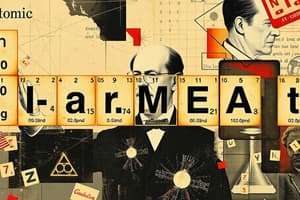Podcast
Questions and Answers
Which statement about the atomic radius is true?
Which statement about the atomic radius is true?
- It increases when moving from left to right across a period.
- It decreases when moving top to bottom in a group.
- It decreases when moving from left to right across a period. (correct)
- It remains the same when moving top to bottom in a group.
The number of valence electrons decreases as you move down a group in the periodic table.
The number of valence electrons decreases as you move down a group in the periodic table.
False (B)
What element has 4 energy levels and 7 valence electrons?
What element has 4 energy levels and 7 valence electrons?
Bromine
As you move from top to bottom in a group, the number of ______ increases.
As you move from top to bottom in a group, the number of ______ increases.
Match the following elements with their number of shielding electrons:
Match the following elements with their number of shielding electrons:
Flashcards
Periodic Law
Periodic Law
This law states that when elements are arranged in order of increasing atomic number, elements with similar properties appear at regular intervals.
Element Identification
Element Identification
The number of energy levels determines the period of an element, while the number of valence electrons influences the element's chemical properties.
Shielding Electrons
Shielding Electrons
The number of shielding electrons is calculated by subtracting the number of valence electrons from the total number of electrons in an atom.
Atomic Radius Trend
Atomic Radius Trend
Signup and view all the flashcards
Valence Electrons Trend
Valence Electrons Trend
Signup and view all the flashcards
Study Notes
Periodic Law
- Periodic Law states that when elements are arranged by increasing atomic number, elements with similar properties repeat at regular intervals.
Determining Elements
- Elements are organized into families based on similar properties.
- Valence electrons determine the properties of an element.
- Number of energy levels and valence electrons help identify an element and its placement.
Valence and Shielding Electrons
- Valence electrons are the outermost electrons involved in bonding.
- Shielding electrons are inner electrons that shield the valence electrons from the positive charge of protons in the nucleus.
- The number of shielding electrons equals the total number of electrons minus the number of valence electrons.
Atomic Radius Trends
- Atomic radius increases moving down a group (top to bottom) in the periodic table.
- Atomic radius decreases moving across a period (left to right).
Valence Electron Trends
- The number of valence electrons does not change moving down a group.
- The number of valence electrons increases generally moving across a period.
Energy Levels Trends
- The number of energy levels increases moving down a group.
- The number of energy levels remains unchanged moving across a period.
Atomic Radius Example (F vs Cl)
- Fluorine (F) has a smaller atomic radius than Chlorine (Cl).
- This is because fluorine has fewer energy levels, which results in a smaller overall size.
Studying That Suits You
Use AI to generate personalized quizzes and flashcards to suit your learning preferences.




